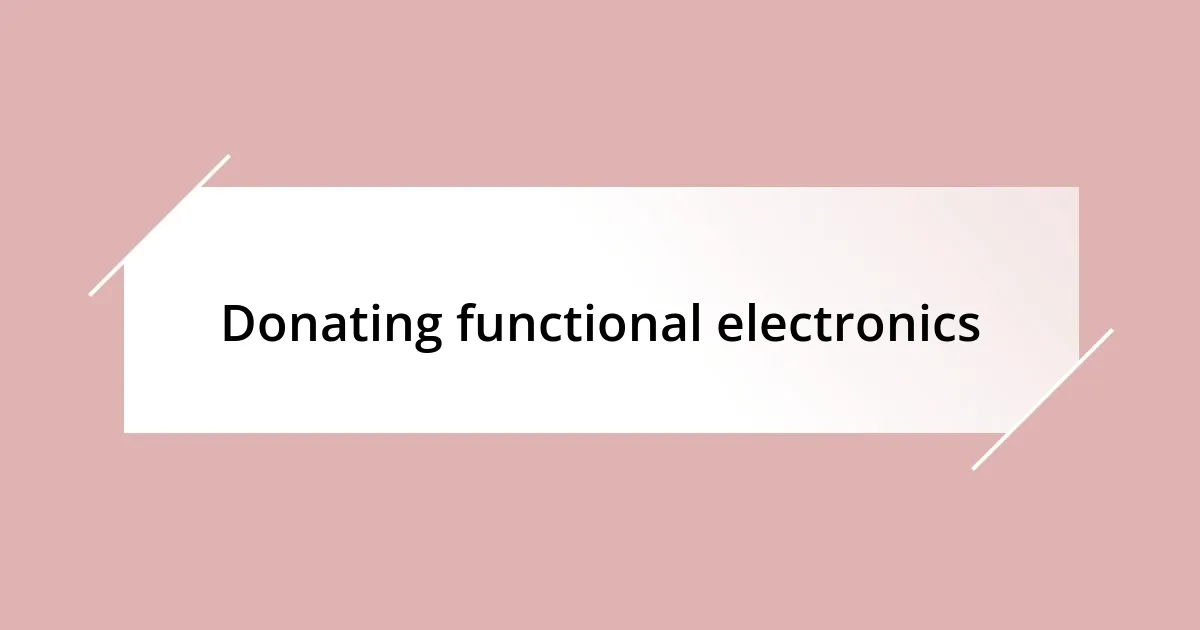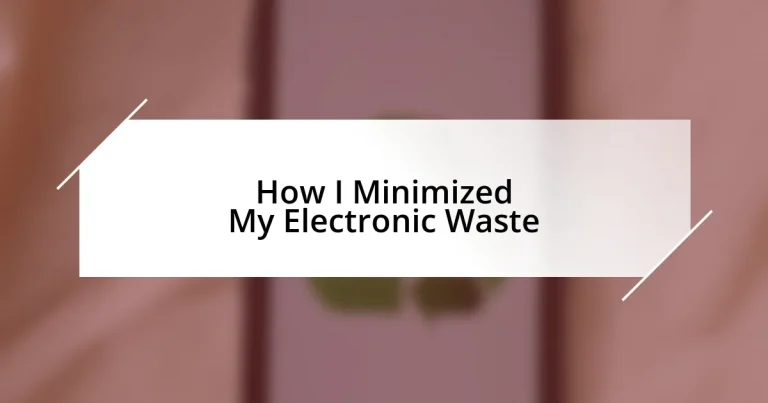Key takeaways:
- Recognizing the environmental and health impacts of e-waste highlights the need for responsible tech consumption and disposal.
- Implementing a recycling strategy and donating functional electronics can empower individuals and reduce waste in landfills.
- Adopting sustainable purchasing habits, such as choosing refurbished items and checking for eco-certifications, promotes long-term environmental care.

Understanding electronic waste
Electronic waste, or e-waste, encompasses discarded electronics like old smartphones, laptops, and appliances, and it can pile up quickly. I remember a time when I decided to declutter my space; I discovered a mountain of obsolete gadgets tucked away in drawers. Have you ever wondered what happens to those devices once they leave your hands?
When I learned about the staggering figures behind e-waste—over 50 million tons generated each year globally—it struck me how much of our technology-driven lives ends up in landfills. It’s not just about the numbers; it’s about the hidden environmental costs. Those old devices were once a part of my daily routine, and I couldn’t help but feel a sense of responsibility toward their ultimate fate.
The reality is that many of these electronics contain toxic materials that can harm our environment and public health. I recall reading about the dangerous substances found inside computers and smartphones, such as lead and mercury, which can leach into our soil and water. It made me question: how can we be more mindful in our tech consumption and disposal practices to ensure we’re not contributing to this growing crisis?

Recognizing the impact of electronics
Recognizing the impact of electronics is crucial in understanding the broader implications of our digital habits. I once had a friend who tossed their old laptop without a second thought, but that moment made me realize how many critical resources are locked away in these devices. To think that every discarded gadget holds precious metals, yet they often end up in landfills, just feels wrong to me.
As I started to educate myself, I discovered that while we rave about the latest tech trends, we’re often blind to the consequences. Each smartphone upgrade I made carried an invisible weight of e-waste potential. It hit home when I learned that recycling one million cell phones could save enough energy to power 185 homes for a year. Doesn’t that put your purchases into perspective?
The sobering truth is that e-waste contains hazardous materials with the potential to pollute our lands and harm ecosystems. I’ve been on hikes where I’ve seen pollution firsthand; it leaves a lingering sadness to think that our choices contribute to that. This harsh reality pushes me to be more responsible, encouraging others to think twice before upgrading or disposing of their devices.
| Type of Impact | Details |
|---|---|
| Environmental | Pollution from toxic materials that leach into soil and water |
| Resource Depletion | Valuable metals and materials are wasted when electronics are discarded |
| Human Health | Exposure to hazardous substances can lead to health problems |

Assessing my electronic inventory
Assessing my electronic inventory was an eye-opening experience. I had no idea just how many gadgets were lurking in my home office. When I began to take stock, I found old smartphones, chargers without devices, and outdated tech that I hadn’t touched in years. It made me realize that a significant part of my inventory was already obsolete, and many items were taking up precious space that could be better used.
- Counted all gadgets, from laptops to headphones, unlocking the hidden clutter in my life.
- Sorted working devices, accessories, and those long-forgotten items that had lost their purpose.
- Evaluated the condition of each item, determining what could be reused, recycled, or donated.
- Faced the emotional weight of memories tied to each device, prompting me to reflect on my consumption habits.
- Created an ongoing inventory checklist to manage devices better in the future and prevent unnecessary accumulation.
As I cataloged my electronics, I recalled the thrill of purchasing my first smartphone and how quickly those feelings faded as it became outdated. The nostalgia hit hard when I stumbled upon a fully functional tablet that I hadn’t used in years. I felt a mix of guilt and relief; while I had once cherished that device, it now represented my past consumer habits. This process wasn’t just about counting; it was about understanding the cycle of consumption and the responsibility that came with it.

Implementing a recycling strategy
Implementing a recycling strategy became a pivotal moment in my journey towards minimizing electronic waste. I set aside one weekend to gather all my old devices, and it was surprisingly cathartic. Seeing those gadgets lined up, I felt a mix of sadness and empowerment; after all, I had the power to change their fate.
I learned that many local electronics retailers offer recycling programs, which was a game-changer for me. Just last month, I dropped off a stack of old chargers and an aging laptop. It felt rewarding to know I was giving these items a second chance instead of letting them collect dust or worse, end up in a landfill. Have you ever felt that rush of doing something good for the environment? It’s validating!
Additionally, I made a point to educate friends and family on the importance of tech recycling. I remember one conversation with my sister, who had no idea that her broken device could be recycled instead of thrown away. It hit me then—spreading awareness is just as crucial as recycling itself. Together, we can cultivate a mindset to rethink our approach to electronic waste, turning it into a collective effort.

Donating functional electronics
Donating functional electronics was a decision that not only lightened my living space but also filled me with a sense of purpose. I discovered local charities that welcomed laptops, phones, and tablets, often using them to help students or individuals in need. The act of dropping off my old devices at a community center felt empowering; it felt good to know someone else could benefit from what I no longer needed.
I distinctly remember the day I donated an old smartphone that still worked perfectly. As I handed it over, I felt gratitude for all the moments the device had captured, from family gatherings to spontaneous adventures. It struck me how our gadgets hold stories, and passing them on, instead of letting them gather dust, allows those tales to continue in new hands. Have you ever wondered how many memories your old devices could still hold for someone else?
The response I received from the organization was heartwarming. They shared stories of how beneficiaries used donated electronics to advance their education or find jobs. It reinforced my belief that each item I passed along was not just a piece of technology; it was a lifeline. Knowing I contributed to someone else’s journey created a profound sense of community, reminding me we all have the power to make a positive impact through our choices.

Adopting sustainable purchasing habits
Adopting sustainable purchasing habits became a transformative experience for me. I started by questioning my need for each new gadget; did I truly require that latest smartphone, or could my current one last a bit longer? Implementing this mindset not only saved me money but also drastically reduced my impulse buys, allowing me to invest in better-quality products that might last longer instead.
I vividly remember the time I opted for a refurbished laptop instead of a brand-new model. It was a small change, but the thought of minimizing waste while still getting a reliable device felt incredibly rewarding. I’ve become a fan of brands that prioritize sustainability, and I’ve found that doing a bit of research pays off—there are so many eco-friendly options out there. Have you ever tried looking up a company’s sustainability practices before making a purchase? It’s eye-opening!
While shopping, I made it a habit to check for certifications like Energy Star or EPEAT. This conscious effort has shifted my perspective; now, I glance at packaging and product descriptions with a more discerning eye. I recall the satisfaction I felt when I chose a solar-powered charger instead of a traditional one. It’s about making choices that ripple out into the larger ecosystem. Is it just me, or does picking up a product that aligns with my values make me feel more connected to the planet?

Creating an electronics maintenance plan
Creating an effective electronics maintenance plan has been a game-changer for me. I began by scheduling regular check-ups for my devices, like cleaning out the dust from my computer vents every few months. Surprisingly, this simple step not only improved performance but also extended their lifespan—who knew that a little maintenance could yield such significant benefits?
One day, while organizing my cables, I stumbled upon an old gaming console. Instead of letting it fade into obsolescence, I decided to test it out. To my delight, it still worked after a good cleaning and software updates! That experience made me realize how vital it is to care for our electronics. How often do we overlook our devices, assuming they’re beyond help? Regularly updating software and firmware can rejuvenate older products, allowing them to serve us longer.
I’ve also started maintaining a digital log for my electronics, detailing purchase dates, warranties, and maintenance tasks. This system keeps me on track, ensuring I don’t overlook necessary repairs or updates. Have you ever thought about how a simple record could help you manage your devices better? I find it empowering—knowledge is always part of the maintenance plan.














